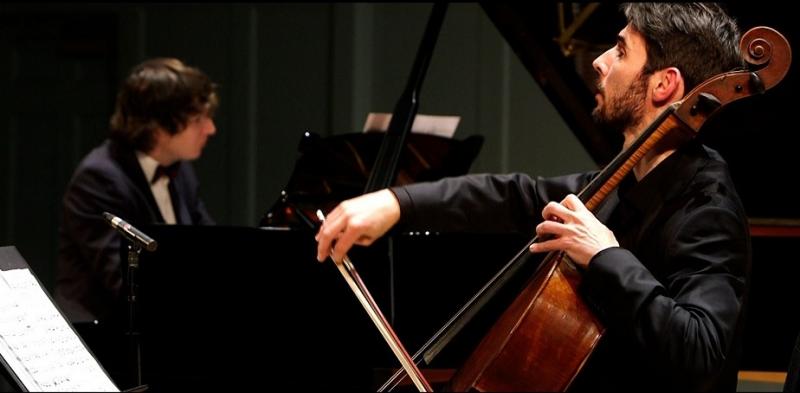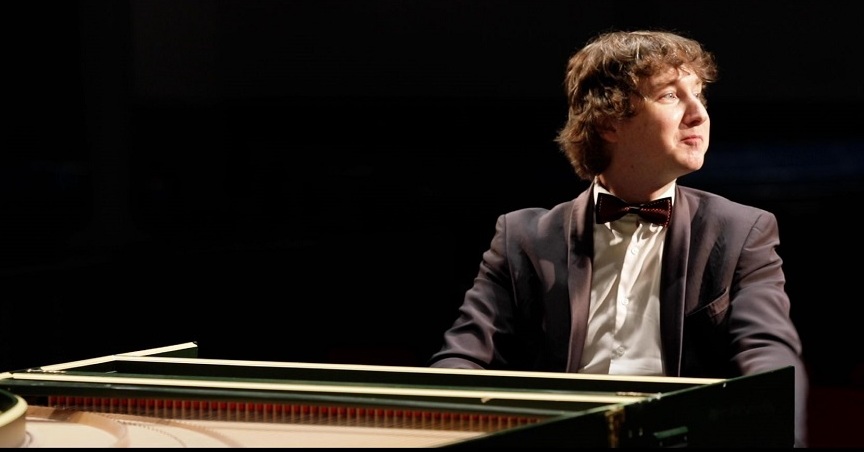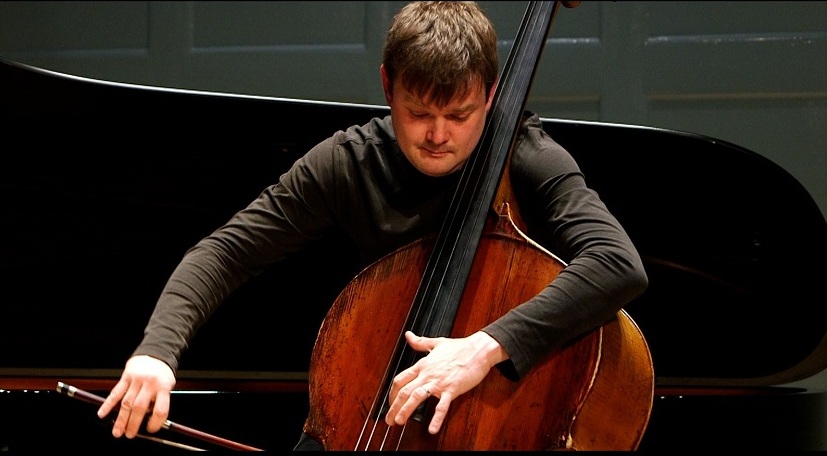Scottish Chamber Orchestra, Emelyanychev online review – versatile virtuosity from Edinburgh | reviews, news & interviews
Scottish Chamber Orchestra, Emelyanychev online review – versatile virtuosity from Edinburgh
Scottish Chamber Orchestra, Emelyanychev online review – versatile virtuosity from Edinburgh
The SCO’s music director leads from the harpsichord and accompanies on the piano

Seated at the harpsichord, Maxim Emelyanychev introduces this concert in charmingly fractured English.
Poised with their instruments, the assembled string quintet looks puzzled, and then the music begins, and it’s clear that whatever skill Emelyanychev (pictured below) may lack as an orator is more than outweighed by his skill as a musician. Hasse’s Adagio and Fugue opens rapturously with a highly expressive descending theme driven by insistently repeated notes. On period instruments, with no vibrato, the rich harmonisation is underscored by the precise, biscuity sound of the harpsichord. It is simply gorgeous. It doesn’t really matter whether it’s by Hasse or anyone else – the programme note describes Johann Adolph Hasse as one of those giants of 18th Century music who despite writing over 63 operas and 90 cantatas has been all but forgotten.  This concert was filmed last month in an inevitably empty Queen’s Hall, musicians widely spaced out on an expanded stage, the audience stalls and famously uncomfortable church pews in near darkness. After the melancholic Adagio, a brisk Fugue leads us to the next piece, the D minor Harpsichord Concerto by Haydn, with Emelyanychev, the SCO’s principal conductor, as soloist.
This concert was filmed last month in an inevitably empty Queen’s Hall, musicians widely spaced out on an expanded stage, the audience stalls and famously uncomfortable church pews in near darkness. After the melancholic Adagio, a brisk Fugue leads us to the next piece, the D minor Harpsichord Concerto by Haydn, with Emelyanychev, the SCO’s principal conductor, as soloist.
This sets off at a cracking pace, glittery and scintillating, the five strings punching above their weight, bold accentuation driving the music forward. You do end up wondering if a full orchestra is really necessary for baroque concertos. Emelyanychev is a persuasive soloist, making the most of some expansive cadenzas, but something about the way he leans into the instrument and coaxes individual notes suggests that he is maybe more of a pianist. The pace never falters, but despite its sunny disposition and relative familiarity I found this a less enthralling performance than the Hasse that preceded it.
There’s no “interval” in a video concert but for the second half Emelyanychev does indeed return as accompanist on the piano, the stage reset with a gleaming Steinway. Principal cellist Philip Higham introduces the next piece: Bruch’s somewhat introspective Kol nidrei, which he describes as a sort of rhapsody on two Hebrew themes. In this lovely performance all the frantic bustle of Haydn’s harpsichord falls away in favour of deeply romantic expression. For once Emelyanychev takes his time, giving Higham space to let the meandering cello line unfold.  There’s another change of mood for the final piece in this concert, Bottesini’s Grand Duo Concertante, introduced by Nikita Naumov, double bass (pictured above), joined here by violin Benjamin Marquise Gilmore and with Emelyanychev once again as accompanist. This is an unashamedly virtuosic showpiece that puts both stringed instruments through a somewhat predictable series of high wire acts before coming to a rousing finale. The violin’s pirouettes are hair-raising enough but Bottesini, patron saint of double-bassists, goes the extra mile to create extraordinary effects high on the fingerboard with ghostly harmonics and finger-stretching arpeggios. The whole piece has the confected air of one of those fantasies based on popular operatic tunes – not great music but great fun.
There’s another change of mood for the final piece in this concert, Bottesini’s Grand Duo Concertante, introduced by Nikita Naumov, double bass (pictured above), joined here by violin Benjamin Marquise Gilmore and with Emelyanychev once again as accompanist. This is an unashamedly virtuosic showpiece that puts both stringed instruments through a somewhat predictable series of high wire acts before coming to a rousing finale. The violin’s pirouettes are hair-raising enough but Bottesini, patron saint of double-bassists, goes the extra mile to create extraordinary effects high on the fingerboard with ghostly harmonics and finger-stretching arpeggios. The whole piece has the confected air of one of those fantasies based on popular operatic tunes – not great music but great fun.
Of course a concert like this would not normally be programmed, were it not for the constraints of lockdown. Viewed on YouTube, the integrity of a concert is prey to digital distraction – no sooner had it finished than my computer started playing a vintage film of a Welsh mountain railway, swiftly followed by Bruch’s violin concerto – such are the fruits of algorithms. But even if a concert like this risks being swamped by the sheer volume of alternative entertainment, it will not be wasted if we take some of the flexibility and adaptability that musicians have demonstrated online and place it back on the live platform in front of an audience.
rating
Explore topics
Share this article
The future of Arts Journalism
You can stop theartsdesk.com closing!
We urgently need financing to survive. Our fundraising drive has thus far raised £49,000 but we need to reach £100,000 or we will be forced to close. Please contribute here: https://gofund.me/c3f6033d
And if you can forward this information to anyone who might assist, we’d be grateful.

Subscribe to theartsdesk.com
Thank you for continuing to read our work on theartsdesk.com. For unlimited access to every article in its entirety, including our archive of more than 15,000 pieces, we're asking for £5 per month or £40 per year. We feel it's a very good deal, and hope you do too.
To take a subscription now simply click here.
And if you're looking for that extra gift for a friend or family member, why not treat them to a theartsdesk.com gift subscription?
more Classical music
 theartsdesk at the Lahti Sibelius Festival - early epics by the Finnish master in context
Finnish heroes meet their Austro-German counterparts in breathtaking interpretations
theartsdesk at the Lahti Sibelius Festival - early epics by the Finnish master in context
Finnish heroes meet their Austro-German counterparts in breathtaking interpretations
 Classical CDs: Sleigh rides, pancakes and cigars
Two big boxes, plus new music for brass and a pair of clarinet concertos
Classical CDs: Sleigh rides, pancakes and cigars
Two big boxes, plus new music for brass and a pair of clarinet concertos
 Waley-Cohen, Manchester Camerata, Pether, Whitworth Art Gallery, Manchester review - premiere of no ordinary violin concerto
Images of maternal care inspired by Hepworth and played in a gallery setting
Waley-Cohen, Manchester Camerata, Pether, Whitworth Art Gallery, Manchester review - premiere of no ordinary violin concerto
Images of maternal care inspired by Hepworth and played in a gallery setting
 BBC Proms: Barruk, Norwegian Chamber Orchestra, Kuusisto review - vague incantations, precise laments
First-half mix of Sámi songs and string things falters, but Shostakovich scours the soul
BBC Proms: Barruk, Norwegian Chamber Orchestra, Kuusisto review - vague incantations, precise laments
First-half mix of Sámi songs and string things falters, but Shostakovich scours the soul
 BBC Proms: Alexander’s Feast, Irish Baroque Orchestra, Whelan review - rapturous Handel fills the space
Pure joy, with a touch of introspection, from a great ensemble and three superb soloists
BBC Proms: Alexander’s Feast, Irish Baroque Orchestra, Whelan review - rapturous Handel fills the space
Pure joy, with a touch of introspection, from a great ensemble and three superb soloists
 BBC Proms: Moore, LSO, Bancroft review - the freshness of morning wind and brass
English concert band music...and an outlier
BBC Proms: Moore, LSO, Bancroft review - the freshness of morning wind and brass
English concert band music...and an outlier
 Willis-Sørensen, Ukrainian Freedom Orchestra, Wilson, Cadogan Hall review - romantic resilience
Passion, and polish, from Kyiv's musical warriors
Willis-Sørensen, Ukrainian Freedom Orchestra, Wilson, Cadogan Hall review - romantic resilience
Passion, and polish, from Kyiv's musical warriors
 BBC Proms: Faust, Gewandhausorchester Leipzig, Nelsons review - grace, then grandeur
A great fiddler lightens a dense orchestral palette
BBC Proms: Faust, Gewandhausorchester Leipzig, Nelsons review - grace, then grandeur
A great fiddler lightens a dense orchestral palette
 BBC Proms: Jansen, Royal Concertgebouw Orchestra, Mäkelä review - confirming a phenomenon
Second Prom of a great orchestra and chief conductor in waiting never puts a foot wrong
BBC Proms: Jansen, Royal Concertgebouw Orchestra, Mäkelä review - confirming a phenomenon
Second Prom of a great orchestra and chief conductor in waiting never puts a foot wrong
 BBC Proms: Royal Concertgebouw Orchestra, Mäkelä review - defiantly introverted Mahler 5 gives food for thought
Chief Conductor in Waiting has supple, nuanced chemistry with a great orchestra
BBC Proms: Royal Concertgebouw Orchestra, Mäkelä review - defiantly introverted Mahler 5 gives food for thought
Chief Conductor in Waiting has supple, nuanced chemistry with a great orchestra
 Dunedin Consort, Butt / D’Angelo, Muñoz, Edinburgh International Festival 2025 review - tedious Handel, directionless song recital
Ho-hum 'comic' cantata, and a song recital needing more than a beautiful voice
Dunedin Consort, Butt / D’Angelo, Muñoz, Edinburgh International Festival 2025 review - tedious Handel, directionless song recital
Ho-hum 'comic' cantata, and a song recital needing more than a beautiful voice
 Classical CDs: Dungeons, microtones and psychic distress
This year's big anniversary celebrated with a pair of boxes, plus clarinets, pianos and sacred music
Classical CDs: Dungeons, microtones and psychic distress
This year's big anniversary celebrated with a pair of boxes, plus clarinets, pianos and sacred music

Add comment